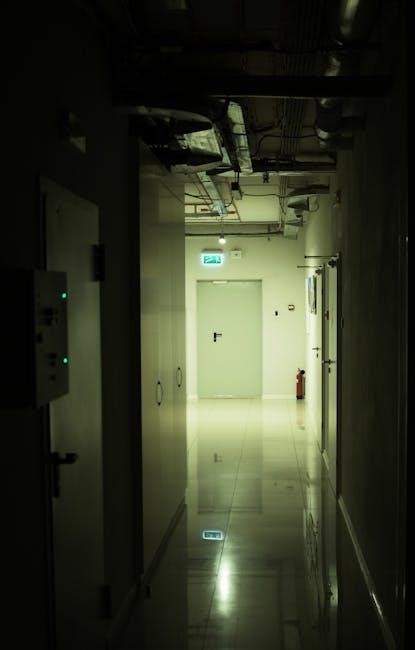Fluke 179 User Manual: A Comprehensive Guide
Fluke leads in electronic testing‚ offering portable‚ safe‚ and user-friendly tools like the 179․ This guide details its features‚ operation‚ and maintenance procedures․
The Fluke 179 is a highly regarded digital multimeter‚ celebrated for its robustness‚ accuracy‚ and comprehensive feature set․ It’s a staple for professional electricians‚ HVAC technicians‚ and anyone requiring dependable electrical measurements․ Originating from a lineage of quality Fluke instruments – building upon the success of models like the Fluke 87 – the 179 offers enhanced capabilities for modern troubleshooting․
This manual provides a detailed exploration of the Fluke 179‚ covering everything from initial setup and operation to advanced functions and safety precautions․ Understanding its capabilities ensures optimal performance and longevity․ Fluke Corporation’s commitment to quality is evident in this tool‚ designed for demanding field conditions and precise diagnostics․
Key Features and Specifications
The Fluke 179 boasts a wide range of features‚ including accurate voltage and current measurement (AC/DC)‚ resistance‚ continuity‚ diode testing‚ and frequency measurement․ It features Auto Volt selection‚ automatically choosing the correct voltage range․ Min/Max/Average recording captures transient events‚ while the Hold function freezes readings for convenient viewing․
Key specifications include a 600V CAT III safety rating‚ ensuring user protection in various electrical environments․ It offers a 20‚000-count display resolution for precise readings․ The meter is known for its durability and reliable performance‚ reflecting Fluke’s industry leadership in test tools and software․ It’s designed for portability and ease of use in demanding professional settings․

Getting Started with Your Fluke 179
Begin by inspecting the meter‚ installing batteries correctly‚ and familiarizing yourself with the display and controls for optimal performance and safe operation․
Unboxing and Initial Inspection
Carefully unpack your Fluke 179 digital multimeter and verify all components are present․ The package should include the meter itself‚ test leads (typically red‚ black‚ and alligator clips)‚ a 9V battery‚ and this user manual․ Inspect the meter for any visible damage sustained during shipping‚ such as cracks in the casing or a damaged display․
Check the test leads for insulation breaks or damaged connectors․ Ensure the battery compartment is secure and shows no signs of corrosion․ If any damage is detected‚ do not use the meter and contact Fluke support or your point of purchase immediately․ Retain the original packaging for potential future transport or warranty claims․ A thorough initial inspection ensures safe and accurate operation from the start․
Battery Installation and Replacement
To install the 9V battery‚ locate the battery compartment on the rear of the Fluke 179․ Gently slide the compartment cover open․ Observe the polarity markings (+ and -) inside the compartment and insert a fresh 9V alkaline battery accordingly․ Ensure the battery snaps securely into place․ To replace the battery‚ repeat this process‚ always using a new‚ high-quality 9V battery․
A low battery is indicated by a battery icon on the display․ Replace the battery promptly when this icon appears to maintain accurate measurements․ Do not mix old and new batteries‚ or different types of batteries․ Dispose of used batteries responsibly according to local regulations․
Understanding the Display and Controls
The Fluke 179 features a large‚ easy-to-read digital display․ It shows the measured value‚ units‚ and various icons indicating measurement mode‚ range‚ and battery status․ The selector dial is used to choose the desired measurement function – voltage‚ current‚ resistance‚ continuity‚ diode test‚ etc․ Function buttons access additional features like Auto Volt‚ Min/Max/Average recording‚ and Hold․
The input terminals accept test leads for connecting to the circuit under test; Familiarize yourself with the location of each control and its corresponding function for efficient operation․ Refer to the diagram within the manual for a detailed illustration of the display and controls․

Measurement Functions
The Fluke 179 accurately measures AC/DC voltage and current‚ resistance‚ and performs continuity and diode tests‚ offering versatile troubleshooting capabilities․
Voltage Measurement (AC/DC)
The Fluke 179 excels in both AC and DC voltage measurements‚ crucial for diverse electrical applications․ To measure DC voltage‚ select the DC voltage range using the rotary dial‚ connect the black test lead to the common terminal and the red lead to the voltage measurement terminal․ Apply the leads across the circuit or component under test‚ and the DC voltage will be displayed․
For AC voltage measurements‚ select the appropriate AC voltage range․ Connect the test leads as described for DC voltage․ The Fluke 179 automatically detects and displays the AC voltage․ Always observe proper safety precautions when measuring voltage‚ especially in high-voltage environments․ Ensure the meter is set to the correct range for accurate readings and to prevent damage to the instrument․
Current Measurement (AC/DC)
The Fluke 179 accurately measures both AC and DC current‚ essential for analyzing electrical circuits․ Important: Current measurement requires breaking the circuit to insert the meter in series․ For DC current‚ select the DC current range‚ move the red test lead to the current measurement terminal‚ and connect the black lead to the common terminal․ Connect the meter in series with the load․

To measure AC current‚ select the AC current range and follow the same series connection procedure․ The Fluke 179 will display the current value․ Caution: Exceeding the current range can damage the meter and blow the internal fuse․ Always start with the highest range and work down for optimal accuracy and safety․
Resistance Measurement
The Fluke 179 measures resistance in ohms (Ω)‚ kilohms (kΩ)‚ and megohms (MΩ)․ Crucially‚ isolate the resistor or circuit being tested – power must be OFF․ Select the resistance measurement range on the rotary dial․ Connect the test leads to the resistor; polarity doesn’t matter for resistance․ The display will show the resistance value․
For accurate readings‚ especially with low resistances‚ zero the meter using the relative mode to compensate for lead resistance․ Higher resistance measurements may take longer to stabilize․ Note: Body resistance can affect readings‚ so avoid touching the metal parts of the test leads during measurement․ Always begin with a higher range and decrease it for better resolution․
Continuity Testing
The Fluke 179’s continuity function quickly checks for complete electrical paths․ Select the continuity mode (often symbolized by a diode or sound wave) on the rotary dial․ Connect the test leads to the two points you want to test․ If a complete circuit exists – meaning very low resistance – the meter will beep audibly and often display a low resistance value․
Important: Ensure the circuit is de-energized before testing continuity․ This function is ideal for checking fuses‚ wires‚ and switch contacts․ A lack of a beep indicates an open circuit or high resistance․ Remember to disable the audible beep if working in a quiet environment․ Always verify the circuit is safe before applying power after a continuity test․
Diode Test
The Fluke 179’s diode test function assesses the functionality of diodes and other semiconductor devices․ Select the diode test mode (typically indicated by a diode symbol) using the rotary dial․ Connect the red test lead to the anode (positive side) and the black lead to the cathode (negative side) of the diode․ A healthy diode will display a forward voltage drop‚ usually between 0․5V and 0․8V․
Reverse biasing – switching the leads – should show “OL” (Over Limit) or a very high resistance‚ indicating the diode is blocking current․ A reading of 0V in both directions suggests a shorted diode‚ while “OL” in both directions indicates an open diode․ This test helps identify faulty semiconductor components within a circuit․

Advanced Features
The Fluke 179 offers Auto Volt‚ Min/Max/Average recording‚ a Hold function‚ and Relative Mode for enhanced measurement capabilities and data analysis precision․
Auto Volt Function
The Auto Volt function on the Fluke 179 is a remarkably convenient feature designed to automatically select the appropriate voltage measurement range․ This eliminates the need for manual range selection‚ saving time and reducing the potential for user error‚ especially when dealing with unknown voltage levels․
When activated‚ the meter intelligently assesses the input signal and adjusts its settings accordingly‚ ensuring accurate readings across both AC and DC voltage measurements․ This is particularly useful for technicians working in dynamic environments where voltage fluctuations are common․ The Auto Volt function enhances efficiency and provides reliable results‚ making the Fluke 179 a versatile tool for a wide range of electrical troubleshooting and maintenance tasks․
Min/Max/Average Recording
The Min/Max/Average recording capability of the Fluke 179 is a powerful diagnostic tool‚ allowing users to capture and analyze fluctuating measurements over time․ This feature automatically records the minimum and maximum values encountered during a specified period‚ alongside the average reading‚ providing a comprehensive overview of signal behavior․
This is invaluable for identifying intermittent issues‚ voltage drops‚ or transient spikes that might be missed with a single reading․ By enabling this function‚ technicians can gain deeper insights into circuit performance and pinpoint potential problems more effectively․ The recorded values are readily accessible on the display‚ facilitating quick analysis and informed decision-making during troubleshooting and maintenance procedures․
Hold Function
The Hold function on the Fluke 179 is designed for convenient measurement capture in situations where direct reading is difficult or impossible․ Activating this feature freezes the current displayed value‚ allowing the user to remove the test leads and examine the reading at their leisure‚ even from a distance․
This is particularly useful when working in poorly lit environments‚ accessing hard-to-reach test points‚ or when needing to record measurements without a second person present․ The held value remains displayed until another measurement is taken or the Hold function is manually deactivated‚ ensuring accurate and reliable data capture․ It simplifies the process of documenting readings and facilitates efficient troubleshooting․
Relative Mode
Relative mode‚ a powerful feature on the Fluke 179‚ allows users to establish a new zero point for measurements․ This is incredibly useful for isolating changes in a circuit or component‚ effectively nullifying the initial reading․ By pressing the REL button‚ the current displayed value becomes the baseline‚ and subsequent measurements are shown as deviations from that baseline․
This function is particularly valuable when measuring resistance‚ capacitance‚ or frequency‚ where absolute values are less important than changes․ It simplifies troubleshooting by highlighting differences and helps identify intermittent connections or component drift․ Relative mode enhances diagnostic capabilities and provides a more focused measurement experience․

Safety Considerations
Always prioritize safety when using the Fluke 179․ Adhere to CAT III 600V ratings‚ use proper test leads‚ and understand electrical safety precautions․
General Safety Precautions
Before using the Fluke 179‚ carefully review all safety information and instructions․ Never operate the meter with damaged test leads or probes; replace them immediately․ Avoid working in wet or damp environments‚ as this increases the risk of electric shock․ Always disconnect the meter from any circuit before changing batteries or fuses․
Ensure your hands and the meter are dry when making measurements․ Do not exceed the meter’s specified input limits․ Be cautious when working with high voltages‚ and always follow established safety procedures․ Never attempt to measure voltages or currents that are beyond the meter’s CAT rating․ Regularly inspect the meter for any signs of damage or wear‚ and discontinue use if any issues are found․ Prioritize personal protective equipment (PPE) when necessary․
CAT III 600V Safety Rating Explained
The Fluke 179’s CAT III 600V safety rating signifies its ability to withstand transient overvoltages found in building installations‚ such as those in distribution panels․ This category protects against disturbances in low-voltage AC power circuits‚ commonly found in homes and light industrial settings․ It’s crucial to understand that CAT III is not suitable for higher-risk environments like industrial power systems (CAT IV)․
This rating ensures the meter can safely measure voltages up to 600V RMS in these specified environments․ Exceeding this rating or using the meter in a higher CAT environment compromises safety․ Always verify the measurement category of the circuit before connecting the meter‚ and use appropriately rated test leads․ Proper adherence to CAT ratings is vital for preventing electrical hazards․
Proper Use of Test Leads
Always inspect test leads for any damage – cracks‚ breaks in insulation‚ or bent connectors – before each use․ Damaged leads compromise safety and measurement accuracy․ Ensure the lead connectors are clean and securely inserted into the meter and the circuit under test; Use only test leads rated for the appropriate CAT III 600V category‚ matching the meter’s rating․
When making measurements‚ maintain a firm grip on the test leads‚ avoiding contact with conductive parts of the circuit․ Never touch the metal probes while the circuit is energized․ Proper lead placement is crucial; avoid creating short circuits․ Regularly check lead resistance‚ as it can affect readings‚ especially in low-voltage measurements․

Troubleshooting Common Issues
Addressing display errors‚ lead connection problems‚ or a meter that won’t power on is crucial for continued functionality․ This section provides solutions for typical issues․
Display Errors and Solutions
Encountering display errors on your Fluke 179 can indicate various issues‚ ranging from simple low battery warnings to more complex internal problems․ A common error involves displaying “OL” or “Overload‚” signifying the measured value exceeds the meter’s range; switch to a higher range setting․
If the display appears dim or shows segments missing‚ first check the battery level and replace if necessary․ A completely blank display often points to a dead battery or‚ less commonly‚ an internal fault requiring professional service․
Error codes‚ if present‚ should be referenced in the full Fluke 179 documentation for specific troubleshooting steps․ Ensure test leads are securely connected‚ as loose connections can sometimes cause erratic readings or error messages․ If problems persist‚ consult Fluke’s support resources․
Lead Connection Problems
Experiencing issues with lead connections is a frequent concern for Fluke 179 users․ A common problem is poor contact‚ resulting in unstable or inaccurate readings․ Ensure the test leads are firmly inserted into the correct input jacks – COM‚ VΩmA‚ and 10A․ Inspect the lead tips for damage‚ corrosion‚ or bending‚ as these can impede conductivity․
If the meter displays “OL” or erratic values‚ even with a known good signal‚ suspect a lead connection issue․ Try wiggling the leads gently while observing the display; any fluctuation indicates a loose connection․ Replace damaged leads immediately․
Always use Fluke-approved test leads for optimal performance and safety․ Avoid using leads with exposed metal or cracked insulation․
Meter Not Powering On
If your Fluke 179 fails to power on‚ begin by checking the battery․ Even seemingly new batteries can be faulty․ Replace them with fresh‚ high-quality 9V alkaline batteries‚ ensuring correct polarity․ A low battery is the most common cause of this issue․
Inspect the battery compartment for corrosion or debris that might be preventing a good connection․ Clean the contacts with a cotton swab and isopropyl alcohol if necessary․ If the problem persists after a battery change‚ there might be an internal issue․
Do not attempt to disassemble the meter yourself; contact Fluke support for assistance․ Tampering with the internal components voids the warranty․

Maintenance and Care
Regular cleaning with a damp cloth ensures optimal performance․ Store the Fluke 179 in a dry place‚ and calibrate it periodically to maintain accuracy․
Cleaning the Fluke 179
To ensure the longevity and accuracy of your Fluke 179 digital multimeter‚ regular cleaning is essential․ Always disconnect the test leads and power source before commencing any cleaning procedures․ Use a soft‚ damp cloth – avoid abrasive cleaners or solvents‚ as these can damage the instrument’s casing and potentially affect internal components․
For stubborn dirt or grime‚ a mild soap solution can be applied to the cloth‚ but ensure no liquid enters the meter’s internal areas․ Pay particular attention to cleaning the display window and the input terminals․ After cleaning‚ thoroughly dry the meter with a clean‚ lint-free cloth․ Avoid storing the Fluke 179 in excessively dusty or humid environments‚ as this can contribute to corrosion and inaccurate readings․ Proper cleaning contributes significantly to reliable performance․
Storage Guidelines
Proper storage is crucial for maintaining the Fluke 179’s accuracy and extending its lifespan․ When not in use‚ store the meter in a clean‚ dry environment‚ protected from extreme temperatures and humidity․ Avoid direct sunlight exposure‚ which can damage the display and plastic components․ Ideally‚ store the meter in its original carrying case or a similar protective container․
Remove the batteries if the meter will be stored for an extended period to prevent potential corrosion from battery leakage․ Keep the test leads neatly coiled and stored separately to avoid damage to the connectors․ Do not store the Fluke 179 with other equipment that may produce corrosive fumes or vibrations․ Following these guidelines ensures your meter remains in optimal condition for years of reliable service․
Calibration Information
Maintaining the Fluke 179’s accuracy requires periodic calibration․ Calibration ensures the meter’s measurements align with traceable standards․ Fluke recommends annual calibration‚ or more frequently if the meter is used in critical applications or experiences harsh conditions․ Calibration should be performed by a qualified technician using calibrated standards․
Fluke offers calibration services‚ or you can utilize an accredited third-party calibration laboratory․ Do not attempt to calibrate the meter yourself unless you possess the necessary expertise and equipment․ Calibration involves adjusting internal components to ensure accurate readings across all measurement ranges․ A calibration sticker will be affixed to the meter indicating the date of calibration and the technician’s signature‚ providing a record of its accuracy․

Fluke Corporation and Support
Fluke is a global leader in test tools and software‚ providing reliable solutions for professionals․ Contact their support for assistance and explore warranty details․
Contacting Fluke Support
Fluke Corporation offers multiple avenues for customer support‚ ensuring users can readily access assistance with their Fluke 179 digital multimeter․ For immediate help‚ visit the official Fluke website – fluke․com – where a comprehensive knowledge base‚ FAQs‚ and troubleshooting guides are available 24/7․
Users can also connect with Fluke’s technical support team via phone․ Regional contact numbers are listed on their website‚ allowing for direct communication with a specialist․ Additionally‚ Fluke provides support through online chat‚ offering real-time assistance for urgent issues․
The website also features a dedicated support portal where users can submit support requests and track their progress․ Fluke actively engages with its community through online forums‚ providing a platform for users to share experiences and solutions․ Remember to have your meter’s serial number ready when contacting support for efficient service․
Warranty Information

Fluke Corporation stands behind the quality of the Fluke 179 with a limited lifetime warranty‚ demonstrating their commitment to customer satisfaction․ This warranty covers defects in materials and workmanship for the lifetime of the product‚ offering peace of mind to users․ However‚ it’s crucial to register your Fluke 179 within 30 days of purchase to activate the full warranty benefits․
The warranty does not cover damage resulting from misuse‚ neglect‚ accidents‚ unauthorized modifications‚ or normal wear and tear․ Fluke will‚ at its option‚ repair or replace the defective instrument free of charge․ To initiate a warranty claim‚ contact Fluke support with proof of purchase and a detailed description of the issue․
Shipping costs to Fluke are the responsibility of the customer․ Detailed warranty terms and conditions are available on the Fluke website (fluke․com) and in the documentation included with your meter․
















































































